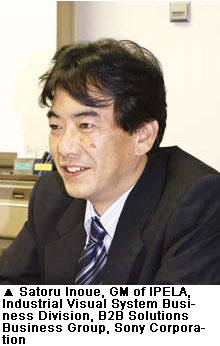Creativity sets Sony apart. As an early bird in IP surveillance, Sony, with its IPELA series, develops beautiful technologies and proposes creative ideas for new applications. A&S talks to the company for its insight into the future of electronic security.
Creativity sets Sony apart. As an early bird in IP surveillance, Sony, with its IPELA series, develops beautiful technologies and proposes creative ideas for new applications. A&S talks to the company for its insight into the future of electronic security.
The electronic security market is moving toward IP "because users have recognized the importance and benefits of picture quality and intelligence," said Satoru Inoue, GM of IPELA, Industrial Visual System Business Division, B2B Solutions Business Group, Sony Corporation. "Compared to three years ago, IP surveillance has been gaining traction. Today, Sony's sales revenue from IP systems exceeds that of analog systems."
Since 2008, there has been increasing demand for megapixel cameras, both in Japan and Europe. According to Inoue, the bestseller is still the IPELA series, particularly the PTZ model. "Given the sour economy, users are looking for value-added features for nonsecurity purposes. We have seen customers use video as a marketing tool."
Tactical Maneuvers
2008 was tough for everyone. "Some projects have been delayed, and we're looking for new ways to improve our visibility in security," said Inoue.
In product development, the emphasis is on HD video. "This not only applies to the IPELA series, but also to the entire security business of Sony, including the FCB group. Key components, CCD and CMOS sensors are all crticial in HD development," said Inoue. Key personnel in the semicondutor and IPELA groups are in constant communication, truly understanding what is demanded. New HD cameras are expected to come out this year.
At the same time, Sony is simplifying the transition to IP for users. Its latest hybrid network surveillance server integrates analog and digital signals on a single platform, enabling existing analog cameras with integrated IP capabilities. Because of the open architecture, the server can also process data from other manufacturers' cameras.
In its exploration for new applications, the company targets commercial verticals with its HD line. "At the entrance, sales floor or cash counter, video can be used for monitoring customers, recording cash exchanges and checking inventory," Inoue said, while pointing out that the zoom function is a must in nonsecurity applications.
Getting Smarter
 To Sony, software weighs equally as hardware. Its software, RealShot Manager, works in sync with the distributed enhanced processing architecture (DEPA), enabling high-quality video processing and intelligent video sensing (such as a preset line being crossed by an intruder). The smart-search function also helps cut down manpower cost.
To Sony, software weighs equally as hardware. Its software, RealShot Manager, works in sync with the distributed enhanced processing architecture (DEPA), enabling high-quality video processing and intelligent video sensing (such as a preset line being crossed by an intruder). The smart-search function also helps cut down manpower cost.
Last summer, Sony launched an online platform named Security Solution Portal. "Our partners can access the site to obtain the latest technical materials, such as SDKs, firmware and application guides," said Inoue. "With our partner program, Sony is able to provide suitable solutions quickly while meeting every customer's needs."
IPELA, or IP plus BELLA (Italian for beautiful), was built on reality, intelligence and usability. "Reality means high picture quality. Intelligence means high processing capability and automated surveillance. Usability means flexibility, such as dual encoding and multicasting."
Greater Freedom
When questioned on the establishment of the Open Network Video Interface Forum (ONVIF) to push for the development of a global standard for the interface of network video products, Inoue pointed out that it was initiated as a response to the strong demand from the market. "End users are looking for a wider variety of products from various vendors in the same installation." With the first, official standard nearly established, industry consolidation can be facilitated.
The standard also helps software vendors support various brands of network video products, bringing benefits to end users. Interoperability means that end users are able to develop their own systems with more flexibility while fully meeting their needs. When expanding or upgrading their systems, there is no limitation on the brand as long as the product complies with the specifications of the standard.
With the ONVIF's official standard, Inoue expects that the adoption of network video products in nonsecurity applications will grow. Committed to standardization, Sony is set to offer unique product features and user benefits to a much broader audience.